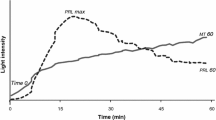Summary
Colour change in the eel resulted in marked ultrastructural changes in the pre-dominating (Type II) secretory cells of the pars intermedia of the pituitary. The effects on these cells of transferring eels from white to black backgrounds for periods of up to 56 days were: a) hypertrophy of the rough endoplasmic reticulum, which increased from 12 to 35% of the cytoplasmic volume; b) loss of secretory granules which decreased from 38 to 5% of the cytoplasmic volume; c) development of a system of fine (25–35 nm) tubules located especially at the secretory poles of the cells but also found in the region of the Golgi apparatus. The tubules were seen to connect with the plasma membrane, with the limiting membrane of the secretory granules, and in one instance to connect a granule with the plasma membrane. After glutaraldehyde fixation at pH 5, electron dense material similar to that found in the secretory granules was observed in the lumen of many of the tubules.
The changes that occurred in black background eels are taken to indicate that the Type II cells of the pars intermedia are responsible for MSH secretion, particularly since these changes were reversed by returning eels to white backgrounds. The cytoplasmic tubules found in Type II cells may indicate a process for MSH release which does not involve granule extrusion, but rather direct transport of material from the Golgi apparatus to the cell membrane.
Similar content being viewed by others
References
Baker, B. I.: The site of synthesis of the melanophore stimulating hormone in the trout pituitary. J. Endocr. 32, 397–398 (1965)
Baker, B. I.: The cellular source of melanocyte stimulating hormone in Anguilla pituitary. Gen. comp. Endocr. 19, 515–521 (1972)
Ball, J. N., Baker, B. I.: In: Fish physiology, vol. III (W. S. Hoar, D. J. Randall, eds.), p. 1–110. New York and London: Academic Press 1969
Cameron, E., Foster, C. L.: Some light and electron microscopical observations on the pars intermedia of the pituitary gland of the rabbit. J. Endocr. 49, 479–485 (1971)
Castel, M.: Ultrastructure of anuran pars intermedia following severance of hypothalamic connection. Z. Zellforsch. 131, 545–557 (1972)
Forbes, M. S.: Observations on the fine structure of the pars intermedia in the lizard Anolis carolinensis. Gen. comp. Endocr. 18, 146–161 (1972)
Hopkins, C. R.: Studies on secretory activity in the pars intermedia of Xenopus laevis. I. Fine structural changes related to the onset of secretory activity in vivo. Tissue & Cell. 2, 59–70 (1970)
Hopkins, C. R.: Localization of adrenergic fibres in the amphibian pars intermedia by electron microscope autoradiography and their selective removal by 6-hydroxydopamine. Gen. comp. Endocr. 16, 112–120 (1971)
Hopkins, C. R.: The biosynthesis, intracellular transport and packaging of melanocyte stimulating peptides in the amphibian pars intermedia. J. Cell Biol. 53, 642–653 (1972)
Howe, A., Maxwell, D. S.: Electron microscopy of the pars intermedia of the pituitary gland in the rat. Gen. comp. Endocr. 11, 169–185 (1968)
Knowles, F., Vollrath, L.: Neurosecretory innervation of the pituitary of the eels Anguilla and Conger. Phil. Trans. B 250, 311–342 (1966)
Leatherland, J. F.: Seasonal variation in the structure and ultrastructure of the pituitary gland in the marine form (trachurus) of the threespine stickleback Gasterosteus aculeatus L. II. Proximal pars distalis and neuro-intermediate lobe. Z. Zellforsch. 104, 318–336 (1970)
Olivereau, M.: Réactions observées chez l'Anguille maintenue dans un milieu privé d'électrolytes, en particulier au niveau du système hypothalamo-hypophysaire. Z. Zellforsch. 80, 264–285 (1967)
Olivereau, M.: Elaboration d'intermédine par les cellules colorées avec l'haematoxyline au plomb dans la pars intermedia de l'Anguille: preuves nouvelles et contrôle hypothalamique. C. R. Acad. Sci. (Paris) 272, 102–105 (1971)
Rodríguez, E. M.: The nervous control of the pars intermedia of an amphibian and a reptilian species. (H. Heller, K. Lederis, eds.). Mem. Soc. Endocr. 19, 827–837. London: Cambridge U. Press 1971
Rodríguez, E. M., LaPointe, J.: Light and electron microscopic study of the pars intermedia of the lizard, Klauberina riversiana. Z. Zellforsch. 104, 1–13 (1970)
Saland, L. C.: Ultrastructure of the frog pars intermedia in relation to hypothalamic control of hormone release. Neuroendocrinology 3, 72–88 (1968)
Schroeder, H. E., Münzel-Pedrazzoli, P.: Application of stereologic methods to stratified gingival epithelia. J. Microsc. 92, 197–198 (1970)
Thornton, V. F.: The effect of background colour on the melanocyte stimulating hormone content of the pituitary of Xenopus laevis. Gen. comp. Endocr. 17, 554–560 (1971)
Waring, H.: Colour change mechanisms of cold blooded vertebrates. New York: Academic Press 1963
Weatherhead, B.: Cytology of the neurointermediate lobe of the tuatara Sphenodon punctatus Gray. Z. Zellforsch. 119, 21–42 (1971)
Weatherhead, B., Whur, P.: Quantification of ultrastructural changes in the melanocyte-stimulating hormone cell of the pars intermedia of the pituitary of Xenopus laevis produced by change of background colour. J. Endocr. 53, 303–310 (1972)
Weibel, E.: Stereological principles for morphometry in electron microscope cytology. Int. Rev. Cytol. 26, 235–302 (1969)
Whur, P., Weatherhead, B.: Rates of incorporation of 3H-leucine into protein of the pars intermedia of the pituitary in the amphibian, Xenopus laevis, after change of background colour. J. Endocr. 51, 521–532 (1971)
Author information
Authors and Affiliations
Additional information
The electron microscope facilities used in this investigation were funded by the Medical Research Council.
Rights and permissions
About this article
Cite this article
Thornton, V.F., Howe, C. The effect of change of background colour on the ultrastructure of the pars intermedia of the pituitary of the eel (Anguilla anguilla). Cell Tissue Res. 151, 103–115 (1974). https://doi.org/10.1007/BF00222038
Received:
Issue Date:
DOI: https://doi.org/10.1007/BF00222038




